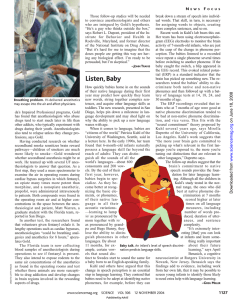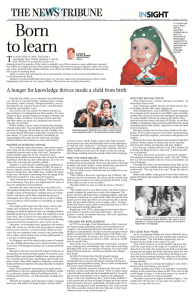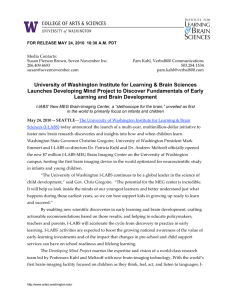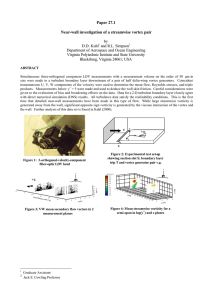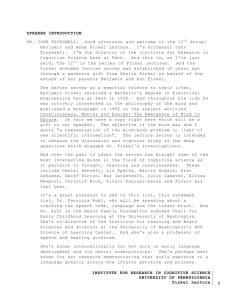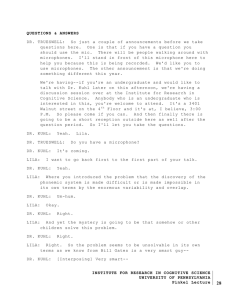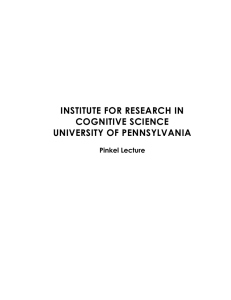Document 12051069
advertisement
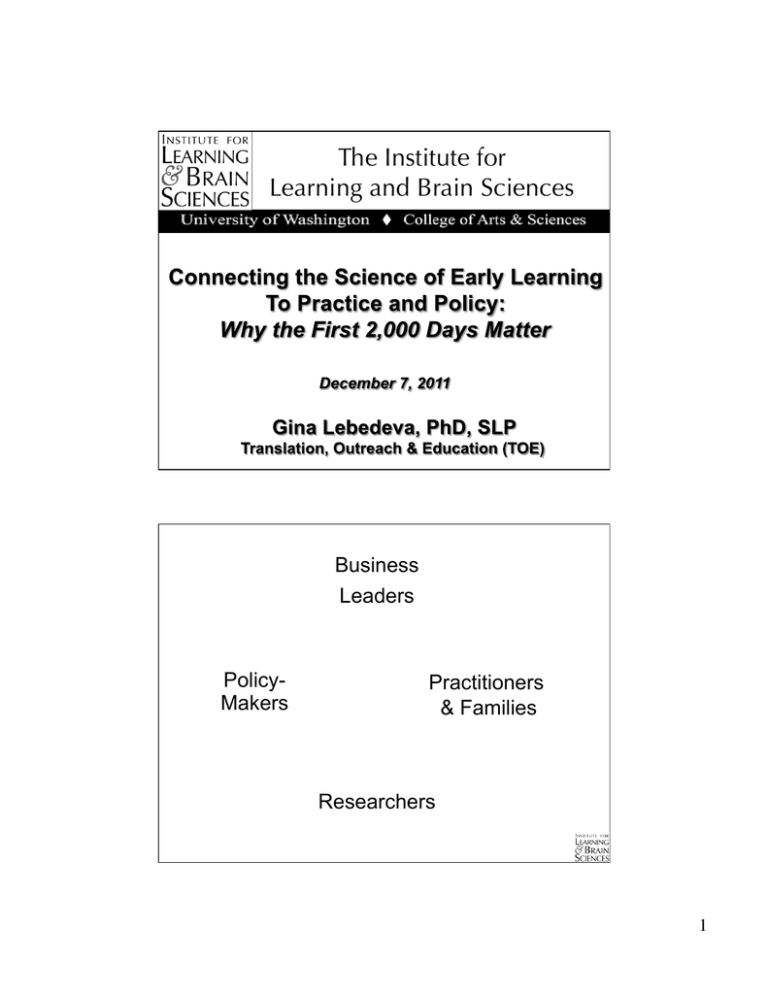
The Institute for Learning and Brain Sciences Business Leaders PolicyMakers Practitioners & Families Researchers 1 Quantifying the Connections Early in Life Health Body Nutrients Quantifying the Connections Early in Life Behavior Brain Environment 2 Early Learning = Early Childhood Experience Quality Predicts Outcomes Funds Cognition The brain is most plastic early in life. + More open to learning from enriched experience. - More vulnerable to impoverished or highly adverse conditions. Cognition • Input • Interaction Brain • Neural Architecture Practice • Key Opportunities 3 More & More Variability is Being Explained Large Variability Exists in Every Aspect of Development Number of Different Words Words Produced Over Time Chronological Age (months) Experience shapes neural circuitry. This is the most efficient early in development. Infant perception of /ra/-/la/ 100 % Correct 90 80 70 60 American Infants Japanese Infants 50 0 6-8 months 10-12 months Werker & Tees, 1984; Kuhl et al., 2006 4 Early Perception Matters Sensitivity to Speech at 7.5 months Predicts Language Growth to 2+ Years More efficient tuning early on is associated with more efficient learning later. At 6 months: At 11 months: Shows discrimination of both native and nonnative contrasts Shows increase in native and decrease in nonnative contrasts + + - - CZ Native Sound Non-Native Sound Mismatch Negativity (MMN) Rivera-Gaxiola, Silva-Pereyra, & Kuhl, 2005; 2008 What makes good brain fertilizer? Gaze Following Safe & Secure Base Following Child’s lead Imitation Book Sharing Why Where Role of Technology Who Input + Interaction How ‘Parent-ese’ Word Diversity How Much When What Commands vs Comments Timing of Responses Bilingualism Cognitive Flexibility 5 How we say it Liu & Kuhl, 2003 How Much We Say Words Per Hour Heard ‘30 million word gap’ by Kindergarten. *Groups are reversed when it comes to amount of ‘directives’ Hart & Risley, 1995 6 Who Says It Live Interaction DVD Session Audio (CD) Session Kuhl, Liu, Tsao, 2003 Brain Response Social Interaction Predicts Language Learning Kuhl 2010; Conboy, Brooks, Meltzoff, & Kuhl, submitted 7 Where we look Gaze + Gesture # Words Produced Long Lookers + Points Short Lookers + Points Long Lookers + No Points “Average” for all kids Short Lookers + No Points Brooks & Meltzoff, 2008 8 Grammatical Complexity of Maternal Language What We Say: Book Sharing Helps Level the Playing Field via Rich Language Weaker SES Profile Stronger SES Profile Lebedeva, Bhagat, Raizada & Kuhl, 2009; Hoff-Ginsburg 1991; Huttenlocher, 2002 • RELATIONSHIPS • Early attachment: warmth, responsiveness, consistency • Social-emotional development and infant mental health • COMMUNICATION • Non-verbal: turn-taking, joint attention, gaze following, gesture, imitation • Self-awareness, self-regulation, thinking reflected through play • LANGUAGE • Vocabulary, grammar, comprehension, narrative skills, pronunciation • Abstract concepts, relating language to experience • PRE-LITERACY • Sound & print awareness; familiarity with books & stories • Home & community literacy practices & routines 9 We are born with all the neurons we will ever have. What’s missing is connections. Biology helps connections start. Experiences sculpt areas to specialize, become more efficient and form networks between areas. Key advances in methods are now allowing research to examine: How white matter development is influenced by environment. Increased mylenation (like electrical insulation) optimizes neural current flow, and is necessary in certain areas. Growth in these areas can be linked to quality of learned experiences early in life. 10 Key advances in methods are now allowing research to examine: How neural tracts that connect brain regions develop. Tractography maps fiber tracts onto structural images. The brain works through a series of networks, which are formed through learned experience, not through simply a matter of time. Key advances in methods are now allowing research to examine: Perception (Wernicke’s Area) Production (Broca’s Area) Real-time synchrony between brain regions, and brains. Tools can localize and provide precise timing information about brain responses. Connections between emotion and language, speaking and listening, or experience and memory, can begin to be related to environmental factors. 11 Early Learning as an Investment • ‘Intervention’ model • Costly Informed Practices • Earlier identification of risk factors Basic Learning Mechanisms • ‘Prevention’ model • Efficient Level Playing Field Raising Awareness to Raise Kids Education as community, not a center Healthcare Providers & Insurers Providers & Educator Trainers Prenatal & Peri-natal Specialists Child Welfare Advocates Early Intervention Teams Mental Health Professionals Policy Makers – Investors – Researchers – Media – Parents 12 Q: What makes healthy bodies? Q: What makes ready & successful children? A: Each Bite. A: Each Bit. Strong Children Healthcare Screening & Support Infant-Toddler programs Strong Schools Strong Families Family, Friend & Neighbor support Individualized Environments Parenting Education P-3 Alignment Family-School Connections Mental Health Strong Professionals Training & Development Credentialing & Quality assurance Compiled from Thrive by Five Washington 13 Opportunity = Knowledge + Creativity 1. What Does the State and National Picture Look Like? 2. What Does Success Look Like? 3. How Well Are We Doing? 4. How Available Is This Support? 5. What is Best Current Evidence? 6. What Infrastructure Must Be In Place? 7. What Are Some Examples of Current Models? 8. What Services and Supports Make a Difference? 9. Where Can We Connect Efforts to Build Momentum & Continuity ‘…Science Curricula…Family Leave…Systematic Data Collection…’ Compiled from Thrive by Five Washington Gratefully acknowledging our partners, collaborators, colleagues, and supporters • NSF Science of Learning Center grant to the University of Washington’s LIFE Center • The National Institutes of Health (NIH) • The Hsin-Yi Foundation • The McDonnell Foundation • The Human Frontiers Science Program • Cure Autism Now Tax-Deductable Contributions: ilabs.washington.edu 14


